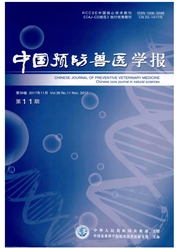

 中文摘要:
中文摘要:
流感病毒血凝素(HA)被宿主蛋白酶切割活化是流感病毒复制和扩散的关键步骤。2009甲型H1N1流感病毒HA的裂解位点为单碱性氨基酸,只能被宿主特定组织部位表达的某些蛋白酶所切割活化。本研究构建了主要存在于人呼吸道和肺脏的跨膜丝氨酸蛋白酶4(TMPRSS4)的真核表达重组质粒pCA-TMPRSS4-Flag与表达2009甲型H1N1流感病毒中国四川分离株HA的真核重组表达质粒pCA-SCHA共转染293T细胞,利用westernblot证明2009甲型H1N1流感病毒的HA蛋白能够被TMPRSS4切割;通过激光共聚焦确定TMPRSS4和HA在293T细胞膜上共定位;并进一步通过细胞融合试验证明经正确切割的HA具有在低pH条件下介导细胞膜发生融合的生物学功能。本实验为研究自然感染情况下参与活化流感病毒的宿主胰蛋白酶提供了实验依据。
 英文摘要:
英文摘要:
Proteolytic activation of influenza virus hemagglutinin protein (HA) plays a key role in virus entry and spread in host. The HA protein of 2009 H1N1 pandemic virus contains monobasic amino acid at its cleavage site which requires certain trpsin-like proteases to activate. To exam the HA cleavage ability of human transmembrane protease, serine 4, (TMPRSS4), we constructed the recombinant plasmid pCA-TMPRSS4-Flag expressing TMPRSS4 which broadly distributes at human respiratory tract and lung tissue. In this study, we co-transfected 293T cells with pCA-TMPRSS4-Flag and the recombinant plasmid pCA-SCHA expressing the HA protein of the 2009 H1N1 pandemic strain (SC) which was isolated from Sichuan in China. The result showed that HA of SC was cleaved by TMPRSS4 detected in western blot and the colocalization of HA, and the TMPRSS4 at cell membrane was further confirmed by confocal imaging. Moreover, we verified that HA induced cell fusion under low pH condition after correctly cleaved by TMPRSS4 through cell fusion assay and immunofluorescence. Our data indicated host serine protease TMPRSS4 may involve in the natural infection of 2009 pandemic influenza.
 同期刊论文项目
同期刊论文项目
 同项目期刊论文
同项目期刊论文
 期刊信息
期刊信息
